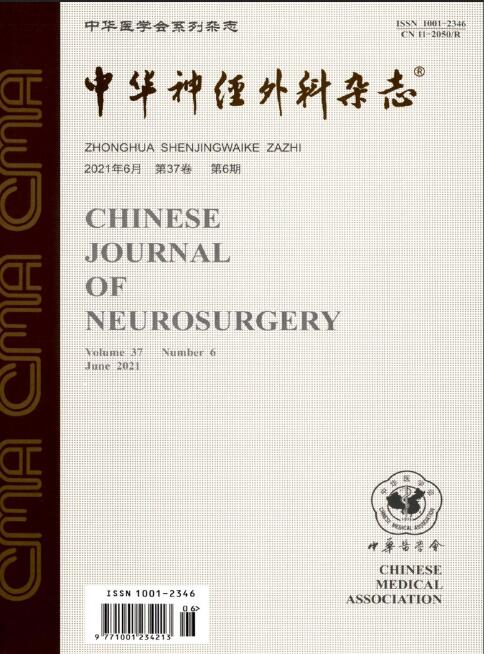脊髓刺激治疗脑损伤后慢性意识障碍110例疗效分析
Q4 Medicine
引用次数: 0
摘要
目的探讨脊髓刺激(SCS)治疗脑损伤后慢性意识障碍(DOC)的疗效及影响因素。方法回顾性分析2011年8月至2017年12月在中国人民解放军总医院第七医学中心神经外科收治的110例脑损伤后慢性DOC患者的临床资料。对颈椎进行CT扫描,以显示植入电极的位置。所有患者均在术后3个月和6个月进行了临床随访。随访包括神经系统体检和基于改良昏迷恢复量表(CRS-R)的评估。根据患者的临床症状结果和CRS-R评分,评估手术结果,并将其分为有效和无效。采用单变量和多变量逻辑回归分析来探讨影响患者预后的危险因素。结果术后进行了宫颈CT检查。将110例患者的电极植入颈脊髓硬膜外C2-C4水平。110例患者的刺激参数包括频率为5Hz或70Hz,脉冲宽度为210μs,电压为1-5V,每日装置接通时间为8-12h,刺激模式为15分钟,间隔15分钟。在这一系列110名患者的手术后6个月,38例有效(24例良好,14例好转),72例无效(67例无效,5例死亡),总有效率为34.5%(38/110)。单因素分析显示,多因素logistic回归分析表明,术前评估推荐标准是影响患者预后的独立危险因素(OR=8.179,95%CI:2.171-30.816,P=0.002),CRS高分是独立的保护因素影响患者的预后(OR=0.304,95%CI:0.095-0.978,P=0.046)。术前评估推荐标准是DOC患者疗效的独立风险因素。关键词:意识障碍;治疗结果;因子分析,统计学;脊髓刺激本文章由计算机程序翻译,如有差异,请以英文原文为准。
Therapeutic effect of spinal cord stimulation on chronic disorders of consciousness after brain injury: A report of 110 cases
Objective
To investigate the efficacy and influencing factors of spinal cord stimulation (SCS) in the treatment of patients with chronic disorders of consciousness (DOC) after brain injury.
Methods
The clinical data of 110 patients with chronic DOC after brain injury were analyzed retrospectively who were admitted to Department of Neurosurgery, the Seventh Medical Center of Chinese PLA General Hospital from August 2011 to December 2017. CT scan of the cervical spine was performed to show the location of the electrode implanted. All patients underwent clinical follow-up at 3 and 6 months after surgery. The follow-up included neurological physical examination and assessment based on modified coma recovery scale-revised (CRS-R). According to the patient's clinical symptom outcome and CRS-R scores, the surgical outcomes were evaluated and divided into effective and ineffective. Univariate and multivariate logistic regression analysis were used to explore risk factors affecting the patient′s outcomes.
Results
Cervical CT was performed after operation. The electrodes of 110 patients were implanted at cervical spinal epidural C2-C4 level. Stimulation parameters in 110 patients included the frequency of 5 Hz or 70 Hz, pulse width of 210 μs, voltage of 1-5 V, daily device-on time of 8-12 h, stimulation mode of 15-min stimulation with 15-min interval. At 6 months post surgery in this series of 110 patients, 38 cases were effective (good in 24 and improved in 14), 72 were ineffective (ineffective in 67 and death in 5), and the overall effective rate was 34.5% (38/110). Univariate analysis showed that age, duration of disease, CRS-R score, and preoperative surgical recommendation criterion were clinical factors affecting the patient′s outcome (all P < 0.05). Further multivariate logistic regression analysis showed that preoperative evaluation recommendation criterion was an independent risk factor affecting the patient′s outcome (OR=8.179, 95% CI: 2.171-30.816, P=0.002). CRS high score was an independent protective factor affecting the patient’s outcome (OR=0.304, 95% CI: 0.095-0.978, P=0.046).
Conclusion
SCS is effective in the treatment of DOC and can be used as one of the feasible treatments for DOC. The preoperative evaluation recommendation criterion is an independent risk factor for the efficacy of patients with DOC.
Key words:
Consciousness disorders; Treatment outcome; Factor analysis, statistical; Spinal cord stimulation
求助全文
通过发布文献求助,成功后即可免费获取论文全文。
去求助
来源期刊

中华神经外科杂志
Medicine-Surgery
CiteScore
0.10
自引率
0.00%
发文量
10706
期刊介绍:
Chinese Journal of Neurosurgery is one of the series of journals organized by the Chinese Medical Association under the supervision of the China Association for Science and Technology. The journal is aimed at neurosurgeons and related researchers, and reports on the leading scientific research results and clinical experience in the field of neurosurgery, as well as the basic theoretical research closely related to neurosurgery.Chinese Journal of Neurosurgery has been included in many famous domestic search organizations, such as China Knowledge Resources Database, China Biomedical Journal Citation Database, Chinese Biomedical Journal Literature Database, China Science Citation Database, China Biomedical Literature Database, China Science and Technology Paper Citation Statistical Analysis Database, and China Science and Technology Journal Full Text Database, Wanfang Data Database of Medical Journals, etc.
 求助内容:
求助内容: 应助结果提醒方式:
应助结果提醒方式:


